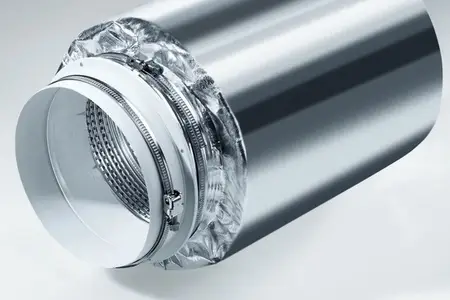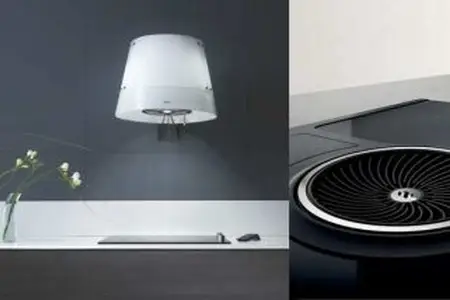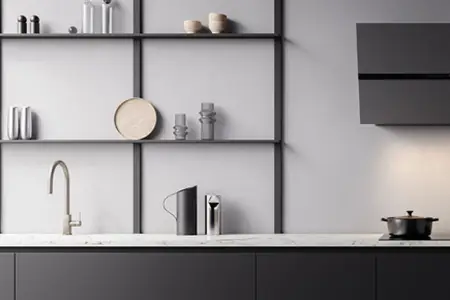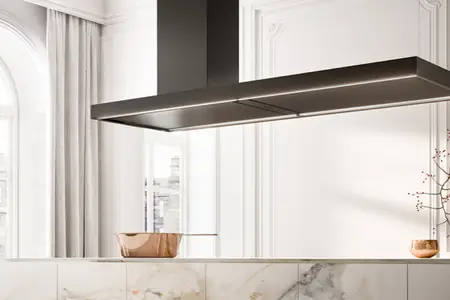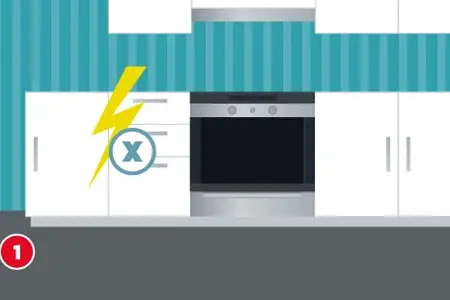The connection of an extractor hood in exhaust air mode to a ventilation duct requires careful planning to efficiently and safely discharge air outside. First, the ventilation duct should have the shortest and straightest possible path to the exterior wall to avoid impeding airflow. Bends and long distances significantly reduce the hood’s performance.
Correct Diameter for the Exhaust Pipe
Another important point is choosing the right pipe diameter. If the ventilation duct is too small, this can lead to air congestion that impairs the extractor hood’s efficiency. Additionally, it must be ensured that the materials used are heat-resistant and stable enough to withstand temperature fluctuations and moisture. Rigid or flexible metal pipes are commonly used here as they are robust and durable.
The sealing of connections between the extractor hood and ventilation duct is also crucial to prevent air from escaping into the room. During installation, backflow dampers should be integrated to prevent cold outside air from entering when the extractor hood is not in operation.
Finally, compliance with applicable building codes and safety standards during installation is essential. This includes minimum distances from combustible materials and correct exhaust air discharge. Professional installation ensures that all these aspects are considered and the extractor hood functions optimally.

Easy Pipe Installation – How Exactly Does It Work?
Installing the pipe for an extractor hood requires precise planning and craftsmanship, whether using a flat channel or round duct. A good guide can help you install the pipe precisely and maximize the hood’s performance. Proper installation ensures that exhaust air is efficiently directed outside. This should be done accurately and carefully to avoid compromising the hood’s performance. Additionally, the connection to the extractor hood and the transition should be done carefully to effectively discharge odors.
1. Installation with Flat Channel
Flat channels are particularly suitable for kitchens with limited space. They can be easily installed behind cabinets or ceiling panels. Start at the extractor hood outlet and run the channel as straight as possible to the exterior wall. Avoid unnecessary bends as these can impair exhaust performance. Individual channel elements are inserted into each other and should be sealed airtight with sealing tape.
2. Installation with Round Duct
Round ducts, usually made of metal or plastic, have better airflow due to their shape and are ideal when space isn’t a major concern. Here too, the pipe should be installed as short and straight as possible to minimize air resistance. Round pipes can usually be attached to the wall using clamp collars, and transitions between pipe sections should be fitted with special seals to prevent air leaks.
3. Connection to the Wall Box
The wall box is the end piece of the ventilation duct that leads the air outside. It is mounted in the exterior wall and should have a backflow damper to prevent cold air from entering. When connecting the pipe to the wall box, the connections must be airtight to ensure an optimal exhaust system. Here too, fixing the pipe connections with sealing tape is recommended. The wall box is usually made of plastic and can be fitted with a stainless steel cover on the exterior wall. This makes it more durable and often visually more valuable than normal plastic versions. A wall box is generally very durable and can be in use for many years.
Exhaust Pipes in 125 mm and 150 mm for Range Hoods: Advantages and Disadvantages
When choosing the right exhaust pipe diameter for a range hood, 125 mm and 150 mm are often the available options. Both sizes have specific advantages and disadvantages.
125 mm Exhaust Pipe – The smaller diameter of 125 mm is commonly used in more compact kitchens. The main advantage is that it’s easier to install, especially in limited spaces or with thinner walls. However, a smaller pipe has higher air resistance, which can reduce the efficiency of the range hood, particularly with high-performance models. This means that airflow is more restricted through the narrower cross-section, which can increase noise levels.
150 mm Exhaust Pipe – The Ø 150 mm exhaust pipe is ideal for more powerful range hoods and larger kitchens. The larger diameter of Ø 150 mm allows air to be expelled with less resistance, increasing the hood’s efficiency. Another advantage is reduced noise generation, as air circulates more gently through the larger cross-section. The disadvantage is that installing a Ø 150 pipe requires more space and may need wall or ceiling modifications.
Conclusion – The choice between 125 mm and 150 mm depends on kitchen size and range hood power. While a 125 mm pipe is more compact and easier to install, the Ø 150 mm pipe offers more efficient air circulation and lower noise levels – ideal for larger kitchens and powerful hoods.
Rigid Plastic Pipes vs. Flexible Ducts for Range Hood Ventilation: Advantages and Disadvantages
The decision between rigid plastic pipes and flexible ducts for range hood ventilation depends on various factors. Both options have advantages and disadvantages that should be considered during planning.
Rigid Plastic Pipes
Advantages:
Rigid plastic pipes offer the benefit of low air resistance due to their smooth interior walls. This means exhaust air is channeled more efficiently outside, reducing noise and increasing range hood performance. They are also durable and stable, making them less susceptible to damage or deformation. Additionally, they are easy to clean, which is particularly beneficial with greasy exhaust air.
Disadvantages:
A disadvantage of rigid plastic pipes is their inflexibility. Installation requires precise planning, and they are less adaptable to confined or irregular spaces. Furthermore, installation often requires more effort, as special angle pieces or connecting elements are needed for each direction change.
Flexible Ducts
Advantages:
Flexible ducts are easy to install, especially in difficult or tight areas where rigid pipes are hard to fit. They are adaptable and can be installed quickly without requiring many additional connecting elements. This makes them excellent for less complex installations or temporary solutions.
Disadvantages:
The main disadvantage of flexible ducts is their higher air resistance. The corrugated interior structure creates more friction, which impedes airflow. This can lead to reduced range hood efficiency and increased noise levels. Additionally, flexible ducts are less robust and more susceptible to damage, especially with heavy use or when kinked.
Conclusion
Hard plastic pipes offer better efficiency and durability but are less flexible during installation. Flexible hoses are easier to install but have lower performance and are more susceptible to damage. Depending on your kitchen layout and hood requirements, you should choose the appropriate variant for your exhaust air routing.

Exhaust solution with only 10 cm hole drilling: Enlarge or switch to recirculation?
If only a 10 cm drill hole is available for exhaust air, you face the decision of whether to enlarge the hole or switch to a recirculation solution.
Enlarging the hole:
A larger opening, ideally 12.5 cm or 15 cm, provides a more efficient exhaust solution. Airflow is improved, hood performance is maximized, and noise generation is minimized. However, it requires structural work.
Switching to recirculation:
The recirculation solution filters the air through activated carbon filters and returns it cleaned to the room. This is a simple alternative when larger holes aren’t possible. However, filter performance is limited, and humidity remains in the room, which can promote mold growth.
Which is better?
If structural modifications are possible, enlarging the hole is the better choice as exhaust systems are more efficient and require less maintenance. They ensure complete removal of cooking vapors and moisture. Recirculation solutions are suitable for buildings where external exhaust isn’t possible, but regular filter replacement is necessary to maintain performance.
The length of the exhaust duct in a range hood
If the exhaust duct is too long or has too many bends, this can also increase noise generation as air must be pushed harder through the constrictions. This affects not only comfort but also the hood’s effectiveness in removing vapors and odors.
The choice of material also plays a role. Smooth, rigid pipes are preferable to flexible hoses as they minimize air resistance. Additionally, all connections should be well sealed to avoid air losses.
In summary: The shorter and straighter the exhaust duct, the better your range hood works. Also ensure the correct pipe diameter and professional installation to guarantee the best possible performance.
Use as few bends and angles as possible
The number and angle of bends in a range hood’s exhaust duct greatly influence the system’s efficiency. Each bend or angle increases air resistance, which slows airflow and can impair the hood’s performance. The sharper the angle (e.g., 90 degrees), the greater the resistance.
Ideally, bends should be minimized and replaced with gentle transitions. Where necessary, you should use the flattest angles possible to facilitate airflow. Sharp bends (like 90-degree angles) should be particularly avoided as they significantly increase air resistance and lead to poorer air extraction.

